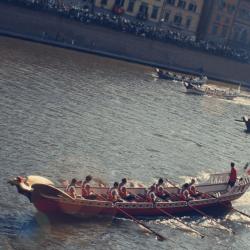
Under the high patronage of the President of the Republic, the Regatta of the Ancient Italian Maritime Republics (RARMI), also known as Palio delle Repubbliche, is an event that has a dual nature, sporting and historical re-enactment at the same time. It was established in 1955 with the aim of celebrating the exploits and rivalry between the most famous Italian maritime republics: Amalfi, Genoa, Pisa and Venice. The first edition took place in Pisa on 1 July 1956, in the presence of the President of the Republic Giovanni Gronchi.
The programme of the event includes a rowing challenge between the four crews representing each of the Republics. The 67th edition to be held in Pisa on Sunday 11th September is somewhat extraordinary, because it is the second to be held in 2022 and because it is held in the month of September. This is because the General Committee, a body that brings together the institutional representatives of the four Republics, has decided to make up for the 2020 edition, which was not held due to the Covid-19 pandemic, by organising two editions in 2022: the first was in Amalfi at the beginning of June and now the Pisa edition at the end of the summer.
An integral part of the event is the historical procession, during which figures parade through the streets of the host city, recalling moments and characters from the history of each republic.
The idea of an event recalling the vicissitudes of the four maritime powers of the Middle Ages was born in the late 1940s thanks to the intuition of the Pisan knight Mirro Chiaverini, who proposed his project to the municipalities of the other three cities so that they would participate. The first joint meeting was held in the halls of Pisa City Hall on 9 April 1949.
Finally, on 10 December 1955, the deed of incorporation was signed in Amalfi, sanctioning the creation of the Organising Body of the Historical Regatta. An experimental trial was held in Genoa, while the boats, built by the Cooperativa Gondolieri di Venezia, were launched on 9 June 1956 on the Riva dei Giardini Reali. The first edition of the Regata ARMI was held in Pisa on 1 July 1956, with Venice winning.
Since then, every year (except, precisely, in 2020) the event has been held, which is a moment of celebration of the glorious history of the four heir cities of the Ancient Republics through the re-enactment parade, a splendid occasion to show off the historical hand-made clothes made with precious fabrics of exquisite workmanship and craftsmanship, and the exciting challenge of the galleons, which enhances the skills of the crews, consisting of 8 rowers and a helmsman.
THE PROGRAMME
67th Regatta of the Ancient Italian Maritime Republics
Pisa, 10-11 September 2022
Saturday 10 September
4.30 p.m. Arno
Rowing race with mixed crews (distance 1,500 metres)
departure from Ponte della Cittadella and arrival Scalo dei Renaioli
6.00 p.m. Piazza dei Cavalieri, church Cavalieri di Santo Stefano
Commemorative ceremony of the first Regatta in 1956
to follow,
Piazza dei Cavalieri
Prize-giving ceremony Palio remiero with mixed crews
Presentation of the crews of the 67th A.R.M.I. Regatta
Sunday 11 September
4.30 p.m. Lungarno Mediceo and Lungarno Galilei
Historical procession of the Ancient Italian Maritime Republics
departure from Giardino Scotto
6.00 p.m. Arno
67th Regatta of the Ancient Italian Maritime Republics (distance 2,000 metres)
departure from Aurelia Bridge and arrival Scalo dei Renaioli
6.30 p.m. Scalo dei Renaioli
Crew prize-giving ceremony
The new procession
The new conformation of the Pisan procession covers a time span spanning the four most important centuries in the city's history, with particular emphasis on the heyday of the medieval phase, which runs from the 11th century through the 1200s. This is the period beginning with the Consular Regency of 1080 through the Podesta Regency of 1190, with the birth of the Commune and then the People's Government of 1254, until its decline in 1406. Five groups are depicted in the procession, with figures from the political, military, socio-economic, and seafaring orders, for a total of 87 figures, recalling important episodes and characters well known to popular memory.
The emperor is represented by an imperial banner; Uguccione della Faggiola is recognizable by the typical biretta visible in his rare iconography and depicts the victorious Battle of Montecatini in 1315; the taking of Jerusalem in 1099 is symbolized by the "Cross of the Pisans." the conquest of the Balearic Islands in 1115 with the "Signum Rubicundum"; the noble and powerful Pisan families that held power are revived in the four noblewomen; and again, Ugolino della Gherardesca, mentioned by Dante in Canto XXXIII of the Inferno and the great mathematician Leonardo Pisano, known as Fibonacci.
Still prominent in the procession is the female character of Kinzica, of the noble Sismondi family, to whom legend attributes the rescue of the city from the Saracen onslaught of 1004, when she caused the bells to ring in flocks to warn the people of the danger looming over the city.